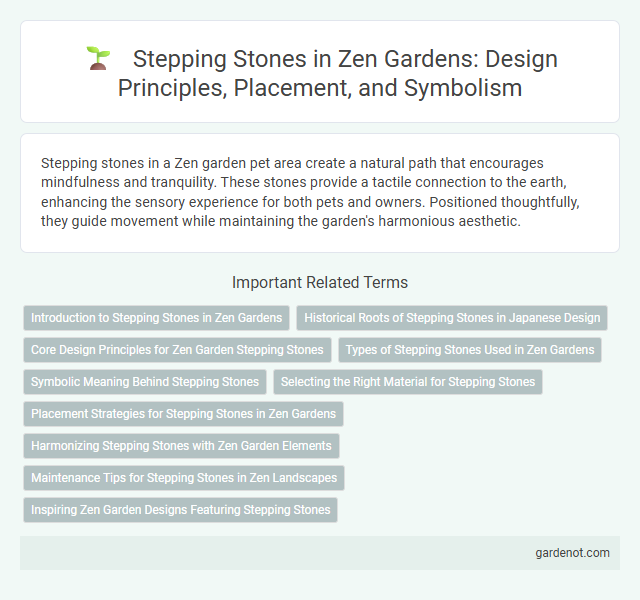Stepping stones in a Zen garden pet area create a natural path that encourages mindfulness and tranquility. These stones provide a tactile connection to the earth, enhancing the sensory experience for both pets and owners. Positioned thoughtfully, they guide movement while maintaining the garden's harmonious aesthetic.
Introduction to Stepping Stones in Zen Gardens
Stepping stones in Zen gardens serve as purposeful pathways that guide visitors through the serene landscape while encouraging mindful movement. These carefully placed stones emphasize balance, harmony, and the natural flow of energy, reflecting the garden's philosophical roots in Zen Buddhism. Their arrangement often symbolizes a journey or meditation, inviting contemplation and a deeper connection with nature.
Historical Roots of Stepping Stones in Japanese Design
Stepping stones, or iso-watari, have deep historical roots in Japanese Zen garden design, symbolizing a mindful journey through nature. Originating from traditional temple gardens of the Heian period, these stones guide visitors along meditative paths, harmonizing movement with surrounding aesthetics. Their placement emphasizes balance, rhythm, and the spiritual progression central to Zen philosophy.
Core Design Principles for Zen Garden Stepping Stones
Stepping stones in Zen gardens embody simplicity, harmony, and natural flow, aligning with the core design principles of minimalism and balance. They guide movement and perspective, creating a meditative pathway that connects various elements while maintaining asymmetrical placement to evoke natural landscapes. The use of natural materials like granite or slate enhances tactile experience and integrates seamlessly with the surrounding environment, reflecting the Zen philosophy of understated elegance.
Types of Stepping Stones Used in Zen Gardens
Stepping stones in Zen gardens typically include flat, irregularly shaped rocks known as Tobi-ishi, which guide visitors through the garden while promoting mindful walking. Smooth, circular stones called Engetsu-ishi are often used to symbolize the moon, enhancing the garden's spiritual atmosphere. Natural materials like granite, sandstone, and basalt are favored for their durability and harmonious appearance within the minimalist landscape.
Symbolic Meaning Behind Stepping Stones
Stepping stones in a Zen garden symbolize the journey of life, guiding practitioners through mindfulness and intentional movement. Each stone represents a mindful step toward spiritual enlightenment, encouraging presence and contemplation. Their arrangement reflects harmony and balance, reinforcing the interconnectedness of nature and self-awareness.
Selecting the Right Material for Stepping Stones
Selecting the right material for stepping stones is crucial in creating a harmonious Zen garden. Natural stones like granite, slate, and sandstone offer durability and a timeless aesthetic that blends seamlessly with moss and gravel. Choosing slip-resistant surfaces and weather-resistant materials ensures safety and longevity, enhancing both the garden's function and meditative ambiance.
Placement Strategies for Stepping Stones in Zen Gardens
Effective placement strategies for stepping stones in Zen gardens emphasize natural flow and balance, guiding visitors through the tranquil space while encouraging mindfulness. Stones are arranged to mimic irregular natural paths, often spaced irregularly to slow walking pace and enhance contemplation. Positioning stones on stable, well-drained ground ensures safety and durability, while integrating elements like moss or gravel around the stones enriches the garden's harmonious aesthetic.
Harmonizing Stepping Stones with Zen Garden Elements
Stepping stones in a Zen garden are meticulously arranged to harmonize with surrounding elements such as raked gravel, moss patches, and bamboo fences, creating a balanced flow that encourages mindful walking. Their natural shapes and textures complement the garden's minimalist design, enhancing the overall sense of tranquility and connection with nature. Thoughtful placement of these stones guides visitors gently through the space, fostering a meditative experience aligned with Zen principles.
Maintenance Tips for Stepping Stones in Zen Landscapes
Regularly sweep stepping stones in Zen gardens to remove debris and prevent moss buildup that can cause slipperiness. Periodically check the stones for stability and reset any that have shifted or become uneven to maintain a smooth, safe path. Apply a gentle water rinse to preserve the natural texture while avoiding harsh chemicals that could harm surrounding plants or disrupt the Zen aesthetic.
Inspiring Zen Garden Designs Featuring Stepping Stones
Stepping stones serve as essential elements in inspiring Zen garden designs, guiding visitors through serene landscapes while promoting mindfulness and balance. Crafted from natural materials such as granite or slate, these stones create harmonious pathways that blend seamlessly with the garden's minimalist aesthetics. Incorporating irregular shapes and varying sizes, stepping stones enhance the tranquil atmosphere by encouraging slow, deliberate movement and contemplation.
Stepping stone Infographic

 gardenot.com
gardenot.com